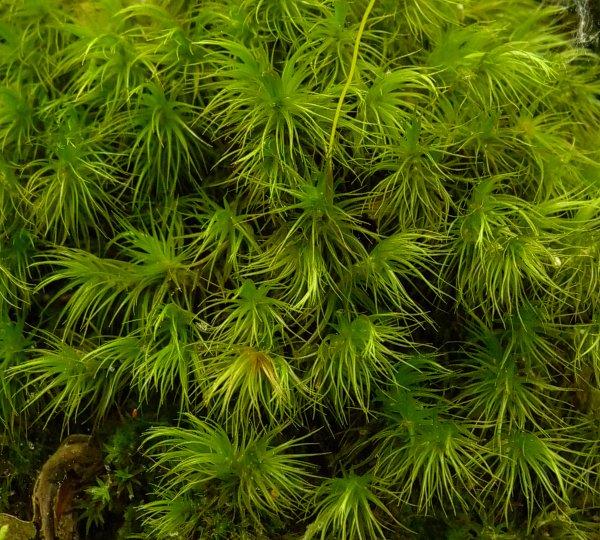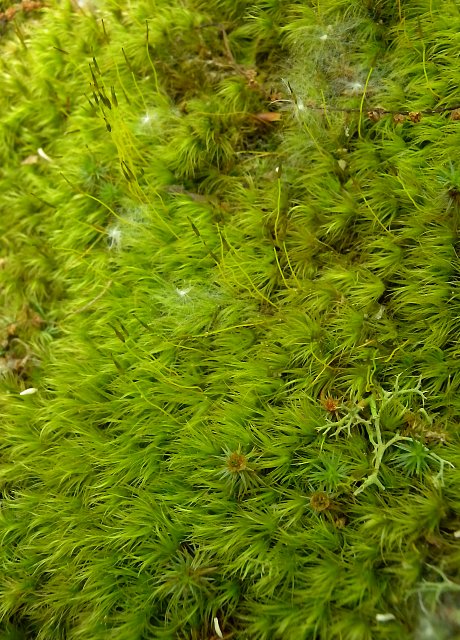
At maturity, the capsule bodies are 2.5–3.5 mm. long, ellipsoid-cylindrical in shape, somewhat curved to one side, and orange to reddish brown. The lids (opercula) of these capsule bodies taper abruptly into long beaks; they are about 2.5–3.5 mm. long and orange to reddish brown at maturity. The hoods (calyptrae) covering the lids and capsule bodies are long-beaked, membranous, and hairless; they soon fall to the ground. After the lids fall from the capsule bodies, a ring of 16 teeth is revealed. The spores in each capsule are released through the circular opening between the teeth, and they are released to the wind. Individual spores are about 14-24 micrometers across and minutely warty. Individual plants are anchored to the ground by their buried lower stems and coarse rhizoids.
Description: The preference is partial sun to medium shade, wet to dry-mesic conditions, and an acidic ground soil containing humus. This moss will also grow on acidic rocks if there is a thin layer of soil or other organic material across their surfaces.
Range & Habitat: Windswept Broom Moss (Dicranum scoparium) is occasional in Illinois and widely scattered throughout the state (see Distribution Map), where it is native. This moss is widely distributed in North America, and it also occurs in Europe, Asia, Australia, and New Zealand. In Illinois, habitats include ground soil in upland woodlands, thinly wooded bluff tops, wooded hillsides, upper slopes of ravines, shaded banks along creeks and rivers, sandstone outcrops, sandstone cliffs, partially shaded rocky ground, well-rotted logs in sandy savannas, sandy ground at tree bases, and Tamarack swamps. Windswept Broom Moss is usually found in upland wooded areas, especially if they are rocky, although it occasionally occurs on shaded wet ground where competition from other plants is reduced. This is a relatively long-lived and fairly conservative species.

Faunal Associations: Colonies of this moss provide hiding places for many small invertebrate animals. A lace bug, Acalypta duryi, feeds on this moss in North Carolina and other areas of the SE United States (Wheeler & Reeves, 2004). In general, lace bugs in this genus feed on mosses. In Europe, larvae of crane fly species and moth species are also known to feed on this moss.
Photographic Location: The slope of a large sandstone ravine at Portland Arch Nature Preserve in west-central Indiana.
Comments: This is an attractive, moderately large moss, with graceful curved leaves. It is the most common species of its genus in Illinois. There are several native Dicranum spp. (Broom Mosses) in Illinois; they vary considerably in size and in the orientation of their leaves. Windswept Broom Moss (Dicranum scoparium) is rather distinctive because of its large size and the tendency of its leaves to curve in the same direction. One species, Dicranum fuscescens, has similar-sized leaves that are also falcate-secund (arc in the same direction), but its leaves become more curly and crisped when they become dry. This species is very rare in Illinois, if it occurs at all within the state. Another very rare species within the state, Dicranum majus, also has falcate-secund leaves, but they are longer (8-12 mm. in length), and individual plants of this species often produce multiple spore-bearing capsules on long stalks, rather than solitary ones. Yet another species of this genus, Dicranum polysetum, is also rare in Illinois. This latter species has slightly longer leaves (7-10 mm. in length) that are often falcate (form arcs), but they curve in different directions and its leaves are more wrinkled in appearance, whether they are moist or dry. The other Dicranum spp. (Broom Mosses) that occur within the state have smaller leaves than Windswept Broom Moss.